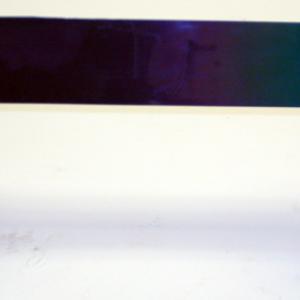College of Liberal Arts & Sciences
4B30.53 - Heat Transfer - Liquid Crystal Indicator
Turn up the hot plate with the aluminum top to 225 on the heat dial setting. Place the pink insulating foam on top of the small lab jack and raise it until it is level with the top of the hot plate. Place the liquid crystal apparatus so that one end is on the hot plate and the rest is laying on the insulated foam. You should see the colors travel from the hot end of the apparatus to the cool end of the apparatus. This will take several minutes for maximum color travel.
Put cold water in one beaker and hot water in the other. Insert the apparatus and observe the heat conduction from hot to cold with the liquid crystal. This method works but is not the best as the length of the liquid crystal apparatus allows the air to cool the apparatus before the colors at the heated end travels very far to the cold end.
- M. P. Strzys, S. Kapp, M. Thees, J. Kuhn, P. Lukowicz, P. Knierim, and A. Schmidt, "Augmenting the Thermal Flux Experiment: A Mixed Reality Approach with the HoloLens", TPT, Vol. 55, #6, Sept. 2017, p. 376.
- R. D. Edge, "Thermal Conductivity and Liquid Crystal Thermometers", TPT, Vol. 31, #7, Oct. 1993, p. 412.
- Michael E. Bacon, R. M. WIck, and P. Hecking, "Heat, Light, and Videotapes: Experiments in Heat Conduction Using Liquid Crystal Film", AJP, Vol. 63, #4, Apr. 1995, p. 359.
- Brian W. Dodson, Thomas L. Hunzeker, "A Quantitative Demonstration of Conductive Heat Transfer", AJP, Vol. 41, #2, Feb. 1973, p. 281
- Ashley G. Smart. "Laser Beam Remodels Liquid Crystals on the Fly", Physics Today, Vol. 68, #6, June 2015, p. 12.
- "H-395. Liquid Crystal - Hammer Blow", DICK and RAE Physics Demo Notebook, 1993.
- Robert Ehrlich, "I.7. Heat Conductivity Demonstration Using Thermostrips", Turning the World Inside Out and 174 Other Simple Physics Demonstrations, p. 119 - 120.
Disclaimer: These demonstrations are provided only for illustrative use by persons affiliated with The University of Iowa and only under the direction of a trained instructor or physicist. The University of Iowa is not responsible for demonstrations performed by those using their own equipment or who choose to use this reference material for their own purpose. The demonstrations included here are within the public domain and can be found in materials contained in libraries, bookstores, and through electronic sources. Performing all or any portion of any of these demonstrations, with or without revisions not depicted here entails inherent risks. These risks include, without limitation, bodily injury (and possibly death), including risks to health that may be temporary or permanent and that may exacerbate a pre-existing medical condition; and property loss or damage. Anyone performing any part of these demonstrations, even with revisions, knowingly and voluntarily assumes all risks associated with them.

